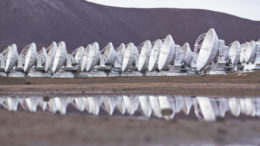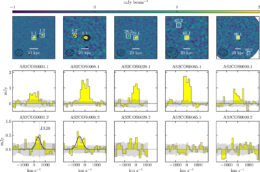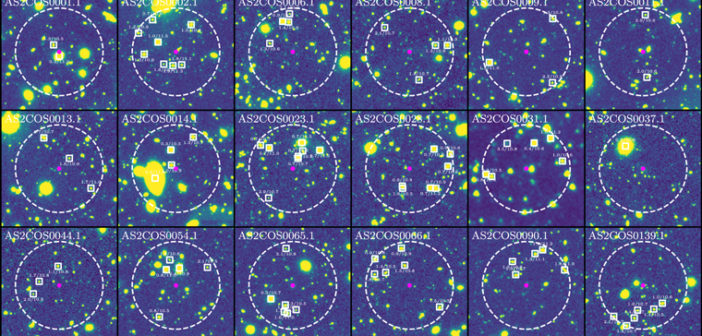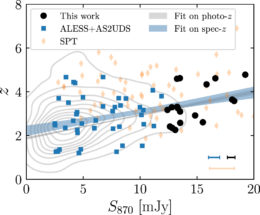Early in the history of the universe, huge, dusty galaxies churned out new stars. A new survey performed with a highly sensitive array of radio telescopes is poised to teach us more about this active period in our universe’s history.

Arrays of radio telescopes like the Atacama Large Millimeter/submillimeter Array are a powerful tool for studying galaxies in the early universe. [Pablo Carrillo – ALMA (ESO/NAOJ/NRAO)]
Early Galactic Goings-On
Galaxies that shine at submillimeter wavelengths — often referred to simply as submillimeter galaxies — offer a window into the evolution of massive galaxies in the distant past. These galaxies generate copious amounts of optical and ultraviolet radiation from their furious star formation, but they’re so dusty that most of the emission that reaches us is longer in wavelength, in the submillimeter range. Submillimeter galaxies are a challenge for observers and modelers alike, as the two groups struggle to agree on how numerous these galaxies are and how their brightness varies over the course of the universe’s history. Can a new, high-resolution survey of the brightest of these galaxies shine a light on the matter?
Submillimeter Survey
In a recent publication, a team led by Chian-Chou Chen (陳建州) from the Academia Sinica Institute of Astronomy and Astrophysics, Taiwan, presented the first results from a new survey of bright submillimeter galaxies from when the universe was 1.2–3.3 billion years old. The sample was drawn from the Cosmological Evolution Survey, which was carried out with the Submillimetre Common-User Bolometer Array 2 instrument, giving the survey the moniker SCUBA-2 COSMOS.
Using the Atacama Large Millimeter/submillimeter Array (ALMA), the team explored several characteristics of 18 of the brightest galaxies surveyed in SCUBA-2 COSMOS:
- Redshift distribution: The median redshift for this sample is z = 3.3, which is higher than that of less luminous galaxies, suggesting that brighter submillimeter galaxies are found at higher redshifts (i.e., earlier in the universe).
- Galaxy pairs: Five of the 18 galaxies investigated in this study are actually two galaxies. Of these, two appear to be physically associated. This implies that 40% of the paired galaxies in the sample are interacting.
- Magnification: By modeling the gravitational field surrounding the galaxies, the team finds that only one is likely to be strongly lensed by a foreground galaxy.
- Mass and number density: The authors estimated the average mass (350 billion solar masses, or about a third of the mass of the Milky Way) and number density (roughly 1 x 10-6 cMpc-3) of the galaxies to compare them to galaxy populations later in the universe.

Images at a wavelength of 870 microns for the five galaxy pairs in the sample (top row). Spectra of the primary (middle row) and secondary (bottom row) galaxies in each pair. Click to enlarge. [Chen et al. 2022]
Interaction Implications
What do these findings imply about galaxies during this time period? The high proportion of submillimeter galaxies that are paired up suggests that interactions between galaxies play a large role in star formation at this stage in the universe’s development. And the true proportion of interacting galaxies may be higher — future surveys tailored to detecting faint emission lines from companion galaxies might reveal more interactions.
Given the masses and numbers of the galaxies studied in this work, it’s possible that bright submillimeter galaxies are an important missing link in the lineage of ancient galaxies: they may be the forebears of quiescent (i.e., not star-forming) galaxies that appear later in the universe — a population whose galactic ancestors have been difficult to determine.
Citation
“An ALMA Spectroscopic Survey of the Brightest Submillimeter Galaxies in the SCUBA-2-COSMOS Field (AS2COSPEC): Survey Description and First Results,” Chian-Chou Chen et al 2022 ApJ 929 159. doi:10.3847/1538-4357/ac61df

